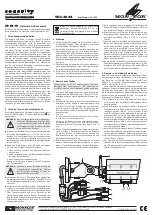
Pike
Technical
Manual
V5.2.3
42
FireWire
FireWire
FireWire hot-plug and screw-lock precautions
Caution
Hot-plug
precautions
•
Although
FireWire
devices
can
theoretically
be
hot-
plugged
without
powering
down
equipment.
Allied
Vision
strongly
recommends
turning
off
the
computer
power,
before
connecting
a
digital
camera
to
it.
•
Static
electricity
or
slight
plug
misalignment
during
insertion
may
short-circuit
and
damage
components.
•
The
physical
ports
may
be
damaged
by
excessive
electrostatic
discharge
(ESD),
when
connected
under
powered
conditions.
It
is
good
practice
to
ensure
proper
grounding
of
computer
case
and
camera
case
to
the
same
ground
potential,
before
plugging
the
camera
cable
into
the
port
of
the
computer.
This
ensures
that
no
excessive
difference
of
electrical
potential
exists
between
computer
and
camera.
•
As
mentioned
earlier,
it
is
very
important
not
to
exceed
the
inrush
energy
of
18
mWs
in
3
ms.
(This
means
that
a
device,
when
powered
via
12
V
bus
power,
must
never
draw
more
than
1.5
A,
especially
in
the
first
3
ms.)
•
Higher
inrush
current
may
damage
the
physical
interface
chip
of
the
camera
and/or
the
PHY
chip
in
your
PC.
For
a
single
Stingray
camera
inrush
current
may
not
be
a
problem.
But
daisy
chaining
multiple
cameras
or
supplying
bus
power
via
(optional)
Hirose
power
out
to
circuitry
with
unknown
inrush
currents
needs
careful
design
considerations.
Screw-lock
precautions
•
All
Allied
Vision
IEEE1394b
cameras
and
cables
have
industrial
screw-lock
fasteners
to
insure
a
tight
electrical
connection
that
is
resistant
to
vibration
and
gravity.
•
Allied
Vision
strongly
recommends
using
only
IEEE1394b
adapter
cards
with
screw-locks.
















































